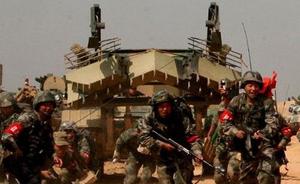China syndromeChina's increasing military might causes concern in Asia, West
China’s recent test flight of its first stealth fighter comes as part of a larger military buildup that is concerning its Asian neighbors and the West; the Chinese test of their first fifth generation stealth fighter is years ahead of U.S. intelligence predictions; China is also moving ahead with the construction of its first aircraft carrier as well as other capabilities like a “carrier killing” ballistic missile; in response to China’s stealth fighter test, Taiwan test-fired nineteen missiles; nearly a third of the missiles failed; it is unclear what China’s intentions are though leaders claim these weapons are for self-defense

Not just size, but modernization are worries // Source: globaltimes.cn
As President Obama met with Chinese President Hu Jintao last week, China’s recent military advances loomed heavily in the background.
China has increasingly flexed its growing military might in public demonstrations to the world. In early January, China revealed its first stealth fighter, the J-20, as Secretary of Defense Robert Gates visited the country in an attempt to restore military relations. Chinese leaders denied that the timing of the aircraft’s first test flight, hours before Secretary Gates was scheduled to meet with Hu, was a show of force.
According to Gates, Hu assured him that the test “had absolutely nothing to do with [his] visit.”
This pace of development has taken a few by surprise.
U.S intelligence analysts had initially predicted that China would not be able to field a fifth generation stealth craft until 2018 with only a handful operational by 2025.
Tamping down fears, U.S. Admiral David Dorsett, director of naval intelligence, admits that the craft entered operational capability more quickly than the United States projected, but believes operational use of the J-20 is years away.
“It is still not clear to me when it will become operational,” he said. “Development of stealth capabilities with a prototype and then to integrate that in a district battle will take time.”
Secretary Gates also downplayed the incident questioning “just how stealthy” the plane really was.
This test is only the latest in several public announcements on China’s military capabilities, which are beginning to challenge U.S. military dominance in the region.
China recently revealed that its new ballistic missile, the Dong Feng 21,capable of striking a moving carrier in a 2,000 kilometer radius, is operational. This effectively prohibits the U.S. from sending its carrier strike groups into Asian waters as ships currently have no defense against ballistic missile attack.
While the United States has been aware that China has been actively developing this capability, U.S. naval intelligence is alarmed by reports from Chinese sources indicating that the weapon system is operational.
This development disturbs U.S. officials as it denies the Navy’s Pacific fleet from effectively operating in the region, especially as China is becoming more aggressive in asserting its territorial claims over disputed waters in East Asia as well as the South China Sea.
In a move that will project power far beyond its borders, China is constructing its first aircraft carrier based on a soviet-era Russian carrier purchased eight years ago.
According to the New York Times, a deluge of news reports allege that China is constructing one or more carriers in Shanghai. The Pentagon believes that China could launch several by 2020.
China’s naval capabilities have rapidly grown in recent years. It currently operates a fleet of sixty submarines that were loaded with multiple warhead nuclear missiles in 2008.
These moves have sparked a regional arms race, with India operationalizing its third aircraft carrier by as early as 2014, Vietnam purchasing six kilo-class submarines from Russia last year, and Indonesia looking to acquire advanced fighter aircraft and transport vehicles.
Taiwan, ever wary of China’s intentions, conducted a rare public test of its own missile capabilities after China unveiled its stealth fighter.
On Tuesday 18 January 2011, Taiwan test fired noneteen surface-to-air and air-to-air missiles with nearly a third failing or missing their targets. The failure of these missiles calls into question Taiwan’s ability to defend itself against a Chinese attack, especially in light of the impending operationalization of China’s J-20.
After the missile tests, embattled Taiwanese president Ma Ying-Jeou, who was present for the drills, said, “I’m not satisfied with the results. I hope the military will find out the reasons and improve its training.”
China insists that its military buildup is peaceful and that these recent developments are meant to bolster its ability to defend its own territory.
With China more aggressively claiming territory and clashing with Japan, Vietnam, and Indonesia over its territorial claims, this military buildup is troubling to American military planners.
China’s leaders maintain an opaque military strategy making it difficult to determine their long term intentions.
“China’s military modernization is certainly their right. What others question is how that military power is going to be used,” said Abraham M. Denmark, the director of the Asia-Pacific Security Program at the Center for a New American Security, a national security think tank in Washington.
